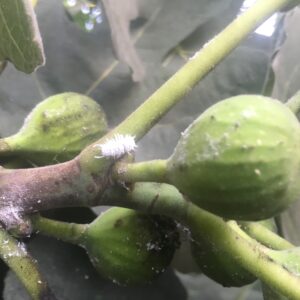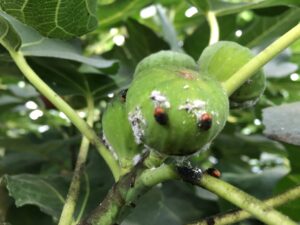2016 Annual Report for FNC16-1062
Integrated Pest Management of Mealy Bugs in Commercial High Tunnels Fig Production
Summary
DESCRIPTION
Mealy bug infestation has become a serious problem during growing figs commercially in the greenhouses. To combat the persistent annually recurring infestation of Mealy bugs we have attempted to apply an integrated pest management control, with a focus on biological control, supported by the 2016 SARE Farmer and Rancher grant. For that purpose we used the Mealy bug Destroyers, Cryptolaemus montrouzieri, a predatory beetle introduced in the US in the late 1980’s from Australia. It is an effective predator of mealy bugs and it has been successfully applied for pest control treatment of Mealy bug infestations of citrus crops. Since there is no mealy bug infestation on our control fig trees grown outside the greenhouses we attribute the problem to the specific conditions created inside the greenhouse, which seem to be perfect for the now recurring mealy bug infestation. Therefore, for this project we have also attempted to manage temperature and humidity in the greenhouses by installing ridge vents on the top of the hoop houses to make those conditions less favorable for mealy bugs.
RESULTS - Managing environmental conditions: Comparison of the results from figs grown in regular hoop house, with only side curtains for venting and a hoop house equipped with ridge vent showed a considerable improvement by delaying the mealy bug infestation from May to August, 2016. This we attribute to the better ventilation of the upper dome of the hoop house. The upper dome in the current hoop houses, retain a lot of moisture, which condenses and drops on the figs and leaf canopy. This creates the perfect conditions for the mealy bugs. They do not have a chitin exoskeleton and depend on the moisture. To adapt and survive they excrete cotton like cellulose fibers that retain water and maintain the necessary high humidity. The 2’ ridge vent, which runs along the whole 96’ of the high tunnel, opens automatically and simultaneously with the 4’ side curtains and creates a “chimney effect” that draws fresh air from outside and exhausts the hot air through the vent.
RESULTS – releasing predatory beetles: Although the ridge vent system had such a significant effect in delaying the Mealy bug infestation from May to August, it could not prevent it further through the later part of the growing fig seasons after August, when the night temperatures start to drop and the curtains close more often and for longer periods at night. On August 25 we introduced the Mealy bug destroyers to combat the exponential Mealy bug infestation. We released a total of 5,000 Mealy bug destroyer beetles, purchased from Arbico Organics. They arrived in perfect condition without any dead insects and were immediately released before dusk among the hoop houses. The Mealy bug destroyer beetles were soon getting on the mealy bugs as seen from the pictures and video clips. And we hoped we were on the right track. However within the next few days, it was getting more and more difficult to find the beetles among the leaves of the enormous leaf mass of the fig trees, and soon we realized that they had almost all escaped from the greenhouses. There weren’t any dead ones found either.
We contacted Arbico Organics to ask for an explanation. They told us that the optimum temperatures for the beetles are between 65 and 85 F. and that they can make it to 95 F, saying that they have them in Arizona. During that time we had a heat wave of 96 F outside, and the curtains and the ridge vent were completely opened under these conditions. We still don’t know if this caused the escape of the bugs outside the greenhouses and are working with Arbico’s specialists to figure out why. They recommended that next year we should try to introduce the beetles much earlier in the season, when the temperatures are not as high and they have more time to adjust to the conditions. We continued to monitor the very few beetles left and later on we found some larvae of the beetles, (see picture).

Late in the season we found some beetle larvae that later hatched into beetles again. This is exciting news because it shows that those predatory beetles that stayed were reproducing under the greenhouse conditions.

OVERVIEW – 2017 season: In 2017 we plan to purchase and release step wise smaller numbers of the Mealy bug destroyers as early as May. We will monitor closely their adaptation to the greenhouse conditions. We will also start our own production of the Mealy bug destroyer in enclosed structures, to adapt them better to the greenhouse conditions. Lincoln University researchers will kindly donate insect cages so that we can keep small numbers of predatory beetles inside along with mealybugs, as a food source. We will record if they survive and reproduce inside the cages. In terms of managing the environment, the installed ridge vent system will help to control better the temperatures and the humidity and maintain optimal temperatures for the beneficial insects inside the greenhouse.